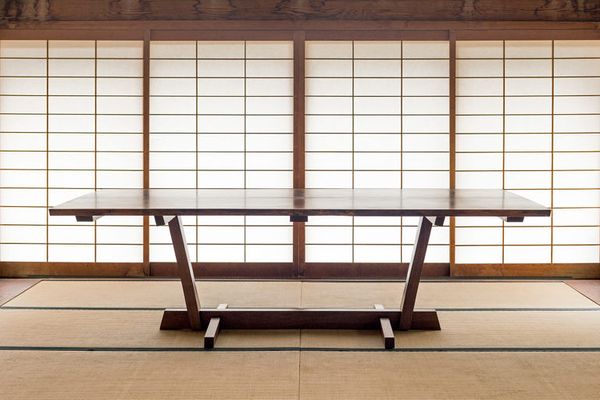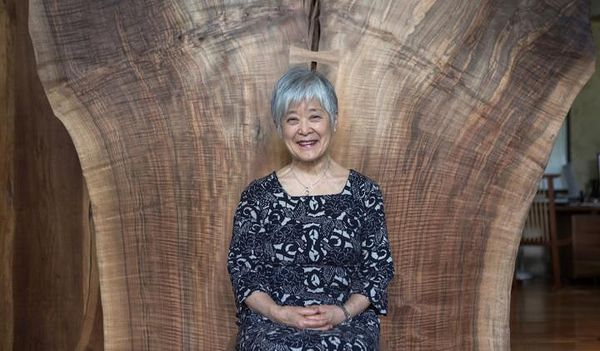Architect Mira Nakashima. Photo by Woong Chul.
Taking over as Creative Director of Nakashima Studios in 1990, Mira Nakashima's work grows from her father George Nakashima's philosophical legacy and expresses her own profound admiration for nature, having lived and worked in close contact with the wood that defines both her artistry and her daily experience. In her designs, Mira captures the form and spirit of the wood, which is capable of transmitting its sensitivity, peace and harmony into the furniture and those who use it.
Trained in her father's craft from a young age, Mira received her formal design education at Harvard and within Waseda University's intensive atelier system, which imbued her conceptual process with a strong belief in the value of collaboration. Under her leadership, Nakashima Woodworkers has expanded its community of craftspeople and integrated design team, which adheres to the approach and philosophy established by George while imagining new, creative solutions.

Nakashima furniture is one-of-a-kind, hand-crafted and made to order in New Hope, Pennsylvania.
PHILLIPS: Is there a specific space or object within your home or studio that you draw inspiration from, or return to, when thinking about new ideas for your work?
MIRA NAKASHIMA: Whenever I go into the Studio basement or any other lumber storage area, I am compelled to make something from all that wood, I enjoy looking through the wood‐piles for ideas and am inspired by the sometimes odd shapes and colors. We are fortunate to be able to supervise the design process, watch each piece grow from a piece of wood into a piece of furniture in the shop, and then come to life, sometimes in surprising ways, in the Finishing Room as many coats of oil are applied and rubbed down.
Our Studios are set on a hill overlooking a scraggly meadow, with some native trees and some trees that my father and grandfather planted many years ago. It is especially inspiring to see the Japanese cherry trees in bloom, remembering how their fleeting beauty and faint sweet scent is so celebrated in Japan. Then the fragile deep purple Japanese Iris bloom, sending up slender stalks of green around the pond. The Japanese weeping thread‐leaf Maple between shops and showrooms is glorious any time of year, from the bare black sinuous branches of winter to tender green leaves in the spring to the brilliant orange shortlived finale of the fall. The passage of time and seasons on our campus, watching the sunset from my desk in the Studio, or the trees dancing in a windstorm are all so inspirational we are grateful to be here in this small village that George built!

Book-matched Conoid Dining Table.
P: When deciding which materials you use in your work, what are the most important factors you consider? Are there any materials you’d like to explore next that you haven’t tried yet?
MN: Usually, I am searching for something the right size, shape and color for a specific client’s needs, but it also needs to suit that client’s personality, budget, or preconceptions. As we have a very healthy grove of bamboo growing behind our house, I am thinking that it would be fun to explore some possibilities of using bamboo. When we were in India two years ago, one of the designers we met had some really interesting objects made of bamboo, and I was blown away by the huge sculptures constructed of bamboo by the Sogetsu School of Flower Arrangement at Longwood Gardens last year.
I find it inspirational to go to a lumberyard, select logs for lumber, and to watch them being cut into lumber, usually for a specific purpose. It is so exciting as each plank of the tree passes through the mill, revealing a beauty no one has ever seen before—and then to find that same plank of wood years later and make it into something new with that awesome remembrance.
P: What challenges do you often face in your design or creative process?
MN: Besides reaching a consensus with client preconceptions or budgetary restrictions within our limitations of wood technology and the extent of available wood, there is almost always a need to resolve the conflict between pure aesthetics, engineering issues, and labor costs.
There is also the danger of repeating forms too often so that they are no longer fresh but as Soetsu Yanagi once said, there is a “variety of sameness”; the concept of “Ichigo, ichi e” in which no two things are ever exactly the same because they were created at different times with different materials, often by different hands

Daybed w/ Maple Burl Headboard, Special Kornblut Cabinet & Desk Lamp.
P: Having to step away from your usual day to day schedule, is there a book/film/project you’ll take this opportunity to begin (or return to)?
MN: I need to finish work on our “Process Book” which has been in process for way too long, and then to research and write an update, revision or sequel to “Nature, Form and Spirit” published by Harry N. Abrams in 2003, which is now out of print.
My cousin, John Terry Nakashima, has been working on a Nakashima Documentary for more than 20 years now, tried to enter it in several film festivals this year which were canceled, but I really look forward to an official viewing sometime in the near future.
P: Where is the future of your practice headed?
We hope to continue both the legacy of designing and making Nakashima furniture and the cultural legacy left behind by my father as well as to preserve his architectural Legacy built on the property for as long as we can. As there are no next‐generation blood heirs directly involved in the furniture business at the moment, our hope is that one of the grand‐children may take an interest. Our Business Manager hired carefully selected younger successors to work in the woodshop and design department; my daughter-in-law works in the office and her son who took woodshop in high school helped us out on weekends when we were open to the public. Although my father founded the non‐profit Foundation for Peace during his lifetime, we are now considering bringing that Foundation under the same umbrella as the woodworking shop as part of our plans for the future.
In the meantime, we have to keep making things with joy and integrity out of those piles of wood my father left behind!
More on Mira Nakashima and George Nakashima Woodworkers
